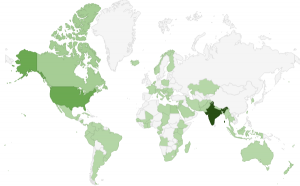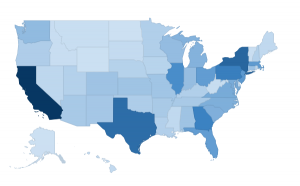On Friday, I’m giving a TED-style talk for our regional school association on what I call the “girl problem” in Computer Science, and how we might fix it. I’ve been preparing for this talk for months, reviewing research about best practices for engaging girls in Computer Science and generally examining the landscape. I work at an all-girls’ school, so you’d think this wouldn’t be an issue for me, but I still have to fight against stereotypes that Computer Science is geeky or boring, and girls’ lack of confidence in their ability to do the work. Once I get them into the classroom, I have a little easier time of it that those of you at co-ed schools. It’s getting them there that’s the challenge. For many of you out there, not only do you have to work to get them there, often you have to work to keep girls in the class and convince them to take the next one. Luckily, there are a lot of smart people out there doing research in this area and every time I turn around, I swear I’m seeing a new report on ways of engaging girls in Computer Science. I want to share with you some of things I’m sharing in my talk about why this is a problem, and what you can do to help fix it.
Why we have a problem
The reasons behind why the percentage of women pursuing a CS undergrad degree has fallen to around 18 percent, half of what it was 30 years ago, are surely complex. Consider, though, the sexism that still exists in our society and that girls find themselves facing at a young age. Think about the toy aisle with its distinct pink and blue color coding. The message that the toy aisle often sends is that girls are meant to be homemakers, caretakers and nurturing while boys are supposed to go places, design things and build stuff. Target got rid of gendered toy aisles and people went nuts.
The idea that boys are better at some things or meant for certain kinds of jobs and girls others permeates the technology industry as well. In my research, I ran across an article just reporting the low percentage of women in the technology industry. The comments on the article fell into two categories: 1) women aren’t as good at technology as men; and 2) women just aren’t interested in technology. Sadly, I’ve seen these attitudes among some educators, and it’s simply not true. Keep in mind that these commenters are often sitting on search committees and are potential co-workers. Their bias might be keeping them from hiring perfectly qualified women. After all, they believe they’re inherently not as good as men at Computer Science and/or are not really interested in the field.
The all-boys’ club image of Computer Science isn’t helped by the media, either. One prime example is Silicon Valley, an Amazon Prime show about a start-up. Sadly, there are no women on the development team, and the guys sit around a house coding all day and sometimes all night. They’re stereotypically socially awkward, especially around women. The show probably doesn’t make being part of a start-up look appealing to girls. There is research that suggests that television shows and films give young people ideas about what kinds of careers are appropriate for men and women. When only 7 percent of the computer scientists in film and only 16 percent of the computer scientists on prime time television are women, they’re certainly not seeing CS as an appropriate career very often (“Gender Roles and Occupation“, 2013).
This cultural environment can make girls not only find CS unappealing, but it can make them feel like they don’t belong, which can lead to a crisis of confidence. Girls already have a tendency to feel like the dumbest kid in the room even when they’re getting the best grades. Boys, on the other hand, feel just the opposite. They might be making Cs, but still see themselves in the top of the class. Girls are less likely to take risks than boys, which is great when it comes to deciding whether or not to skateboard off the railing, but not so great when it comes to trying out a class they’re unsure about. A great book about how girls (and women) feel less confident in their own abilities is The Confidence Code by Katty Kay and Claire Shipman. There’s some fascinating research in there that helped me understand some of my students (and myself) better.
What you can do
Okay, so we have a problem. There are actually some fairly easy things to do. In general, I would say to you, think about the message you’re sending to your students in the way your classroom looks, what kind of assignments you create, how your students are asked to complete those assignments. Think about the toy aisle and whether you’re telling girls this work is not for them.
Look around your classroom. If you have control over how it looks, please tell me it doesn’t look like the set of Star Wars, Dr. Who, or a video arcade. Yes, we geeks like those things, but it can be off-putting for some and send the message that in order to be a part of the class, your students have to like those things, too. Keep your decor neutral. Or maybe add some posters of women in Computer Science to go alongside your Mark Zuckerberg and Bill Gates posters. Think Grace Hopper, Jean Bartik, Maria Klawe, Karli Kloss, or Marissa Mayer. Recent research shows that when the classroom is neutral, girls are three times more likely to show an interest in Computer Science than when the CS classroom is stereotypically geeky. It makes a difference.
Think about your assignments. Are they the same assignments you did in high school? Unless you were in high school a few years ago, it might be time to update them. Connect your assignments to the real world. Many girls particularly like to see practical applications of the work they’re doing in class. Girls, in particular, also like to know that the work they’re doing could potentially help someone or help solve a problem that plagues the world.
Also think about how you have your students work on assignments. Does everyone complete all the assignments individually? Consider using pair programming, peer instruction, and group work. All of these methods not only make the work potentially more appealing to girls, who appreciate the social aspects of work, but they also help all students retain Computer Science concepts. They’re very effective pedagogical strategies.
Finally, encourage your students, especially your female students, along the way. When they make a mistake in class, be supportive, help them learn from it. If a girl seems to like CS, whether or not she’s good at it, encourage her to take another course or enroll in a summer program, or pursue CS at the next level, whether that’s high school, college or graduate school. Recent research from Google shows that encouragement is a key factor in retaining women to continue their student of CS.
If you’re in need of more ideas, there are plenty out there. Here are just a few places to start:


